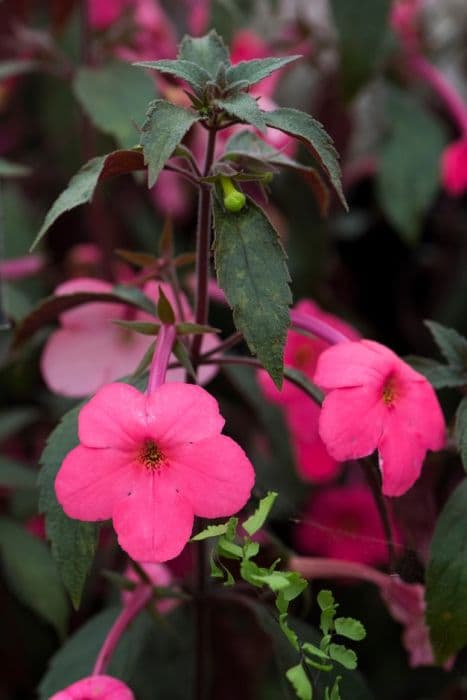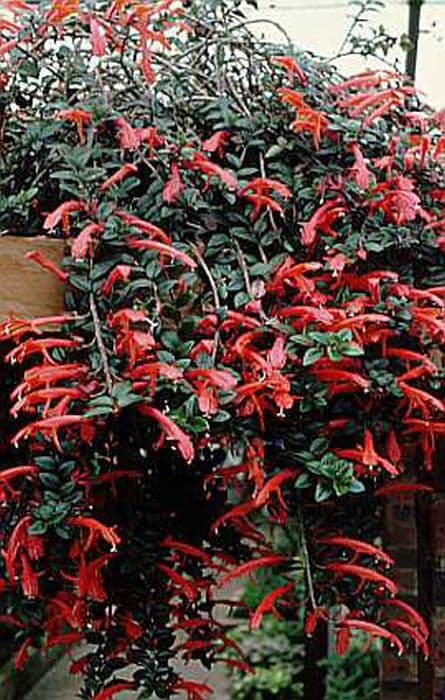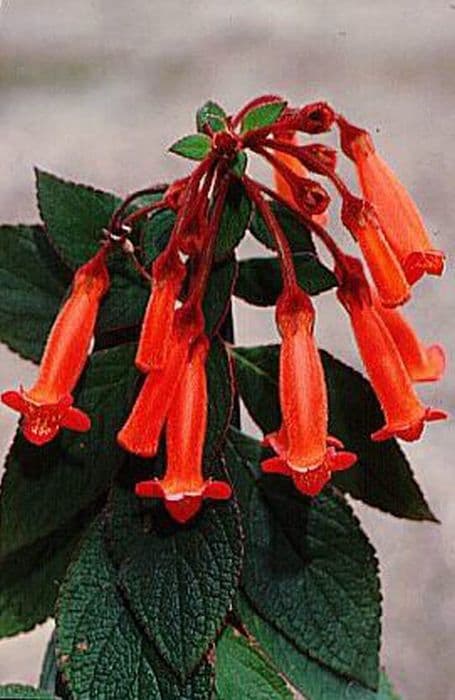Cape Primrose Streptocarpus 'Titania'

ABOUT
Streptocarpus 'Titania', commonly known as Cape Primrose, has a distinctive appearance characterized by its lush, velvety foliage and vibrant, trumpet-shaped flowers. The leaves are typically long and tongue-shaped, with a soft, deep green color that can sometimes have a slightly wrinkled or textured appearance. These leaves grow in a basal rosette pattern, emanating from the base of the plant in a circular fashion. The most striking feature of the Cape Primrose is its beautiful flowers. The blooms come in a variety of colors depending on the specific variety, with 'Titania' often showcasing shades that may vary from lavender to deep violet. Each flower displays a delicate, tubular structure fanning out into five broad petals that are sometimes ruffled at the edges, adding to their ornamental appeal. The throat of the flower is often a contrasting color, adorned with intricate patterns and markings, such as streaks or spots, that can attract pollinators in their natural habitat. Cape Primrose blooms can be found on slender, upright flower stalks that rise above the foliage, each stalk hosting a succession of flowers that can create a beautiful, continuous display of color for an extended period. The overall appearance of Streptocarpus 'Titania' is one of lush, vibrant beauty that can bring a touch of the tropical to any indoor environment.
About this plant
 Names
NamesFamily
Gesneriaceae
Synonyms
Cape Primrose, African Violet
Common names
Streptocarpus 'Titania'.
 Toxicity
ToxicityTo humans
Streptocarpus 'Titania', commonly known as Cape primrose, is not known to be toxic to humans. There are no significant toxic effects reported from ingesting this plant, and it is generally considered safe around children and adults. As with any non-food plant, ingestion of large amounts is not advisable, and if accidental ingestion does occur and any adverse reactions are observed, medical advice should be sought.
To pets
Cape primrose is not considered toxic to pets. There is no significant evidence to suggest that Streptocarpus 'Titania' poses a poisoning risk to cats, dogs, or other household pets. While it is not intended for consumption, ingestion of small quantities is unlikely to cause more than mild gastrointestinal upset. If a pet ingests a large amount or exhibits any unusual symptoms, it is recommended to consult a veterinarian.
 Characteristics
CharacteristicsLife cycle
Perennials
Foliage type
Evergreen
Color of leaves
Green
Flower color
Mixed
Height
6-12 inches (15-30 cm)
Spread
6-12 inches (15-30 cm)
Plant type
Herb
Hardiness zones
10
Native area
Africa
Benefits
 General Benefits
General Benefits- Easy to Care For: Streptocarpus 'Titania' is relatively low maintenance, requiring minimal upkeep to thrive.
- Attractive Ornamental: Its vibrant flowers and lush foliage add aesthetic appeal to any indoor space.
- Long Blooming Period: It can flower for long periods, often providing color for much of the year when kept in ideal conditions.
- Space-saving: With its compact size, it's suitable for small spaces like apartment windowsills or desks.
- Limited Pests and Diseases: This plant is not prone to many diseases or pests, making it a hassle-free addition to any collection.
- Wide Variety of Colors: Comes in a range of colors that can complement any decor or color scheme.
- Propagates Easily: It can be easily propagated from leaf cuttings, allowing gardeners to create new plants.
- Humidity Tolerant: Can tolerate and even thrive in humid conditions, making it an excellent choice for bathrooms or kitchens.
 Medical Properties
Medical PropertiesThis plant is not used for medical purposes.
 Air-purifying Qualities
Air-purifying QualitiesThis plant is not specifically known for air purifying qualities.
 Other Uses
Other Uses- Photography Subject: Streptocarpus, with its vibrant flowers, can serve as a beautiful subject for macro and botanical photography, allowing photographers to capture the details and vivid colors of the blooms.
- Artistic Inspiration: Artists may use the striking appearance of the Streptocarpus blooms as inspiration for paintings, illustrations, and other visual art forms.
- Educational Tool: Biology teachers can use the plant in lessons on plant anatomy, pollination, and the life cycle of flowering plants, due to its distinct reproductive features.
- Companion Planting: Though not commonly recognized for this, Streptocarpus can be grown alongside certain vegetables in a greenhouse to add aesthetic value without competing for resources.
- Handcrafts: The leaves and flowers can be used as natural embellishments for crafting handmade greeting cards or bookmarks.
- Horticultural Competitions: Owners might enter their Streptocarpus plants into flower shows or horticultural competitions for judging based on flower form, color, and plant health.
- Color Dye Source: The petals could potentially be used to create natural dyes for fabric or artwork, although this is not a common use.
- Mood Enhancement: Keeping the plant in living spaces for its bright and cheerful flowers can improve mood and well-being, similar to the effects of art therapy.
- Science Projects: Students can use Streptocarpus to investigate plant growth variables, soil PH preference, or the impact of light on flowering as part of science fair projects.
- Collector's Specimen: Avid gardeners may cultivate rare and unique varieties of Streptocarpus, including 'Titania', as collectible items in their personal greenhouses or gardens.
Interesting Facts
 Feng Shui
Feng ShuiThe Cape primrose is not used in Feng Shui practice.
 Zodiac Sign Compitability
Zodiac Sign CompitabilityThe Cape primrose is not used in astrology practice.
 Plant Symbolism
Plant Symbolism- Persistence: Streptocarpus, commonly known as 'Cape Primrose,' often symbolizes persistence due to its ability to thrive with minimal care and bloom abundantly.
- Enduring Beauty: With its delicate and colorful flowers, Cape Primrose represents enduring beauty, maintaining its attractiveness over a long blooming period.
- Hope and Renewal: Often given as a gift to convey messages of hope and new beginnings, the Cape Primrose, with its regular renewal of flowers, is a symbol of optimism.
 Water
WaterCape Primrose should be watered when the top inch of soil feels dry to the touch, which typically means watering approximately once a week. However, frequency will vary based on environmental conditions such as humidity and temperature. Use room temperature water to gently water the plant, ensuring the soil is evenly moistened without becoming soggy. Avoid getting water on the leaves to prevent fungal diseases. Approximately 8-16 ounces of water per week should suffice, but always adjust based on the plant's response and the current season.
 Light
LightCape Primrose thrives in bright, indirect light. It should be placed in a spot where it can receive a good amount of filtered sunlight, such as near an east or north-facing window. Direct sunlight, especially during the hottest parts of the day, should be avoided to prevent leaf scorch.
 Temperature
TemperatureCape Primrose prefers consistent temperatures between 60 and 75 degrees Fahrenheit. It can tolerate a low of about 50 degrees Fahrenheit but should not be exposed to temperatures below that to avoid cold damage. Ideally, the plant should be kept away from drafts, heating vents, and air conditioners to maintain stable temperature conditions.
 Pruning
PruningPruning Cape Primrose promotes bushier growth and encourages more flowering. Remove spent flowers and yellowing leaves regularly to maintain the plant's appearance and health. The best time for pruning is immediately after a flowering cycle when you notice a decrease in bloom. Depending on the growth, a light pruning every few months is beneficial.
 Cleaning
CleaningAs needed
 Soil
SoilThe best soil mix for Cape Primrose is a light, airy, and well-draining potting mix, often achieved by combining peat with perlite or vermiculite, and a small amount of fine bark. The ideal pH range is slightly acidic to neutral, around 5.5 to 6.5.
 Repotting
RepottingCape Primrose should be repotted annually or when it has outgrown its pot, typically in spring or early summer to allow for healthy root growth and space for new shoots.
 Humidity & Misting
Humidity & MistingCape Primrose thrives at higher humidity levels, preferring a range of about 50-60%. They benefit from being placed on a pebble tray or near a humidifier to maintain optimal humidity.
 Suitable locations
Suitable locationsIndoor
Provide bright, indirect light and keep the plant at room temperature.
Outdoor
Place in filtered light; shelter from harsh sun & heavy rain.
Hardiness zone
10-11 USDA
 Life cycle
Life cycleThe Cape primrose 'Titania', beginning as a seed, germinates in warm, moist soil conditions, emerging as seedlings with a rosette of leaves. It gradually matures, developing a larger rosette and long, strap-like leaves that form a basal cluster. After reaching maturity, which takes several months, it starts to produce flowers on stalks that rise above the foliage, displaying vibrant blooms often in shades of blue, purple, or white. This flowering stage can last several weeks to months, usually more prolific in cooler temperatures and with adequate light. Once pollinated, the flowers will produce seed capsules that twist open when dry, dispersing seeds and completing the reproductive cycle. Under appropriate conditions, the plant can live for several years, often continuing to grow and bloom in cycles throughout its life.
 Propogation
PropogationPropogation time
Spring-Summer
Propogation: The ideal time to propagate Streptocarpus 'Titania', commonly known as Cape Primrose, is typically in spring or early summer when the plant's growth is most active. The most popular method of propagation for Cape Primrose is through leaf cuttings. To do this, a healthy leaf is selected and cut across the width into sections, each with a main vein. These segments are then inserted into a moist, well-drained potting mix, ensuring the cut edge is buried slightly. The pot is then covered with a plastic bag or placed in a propagator to maintain high humidity. In a few weeks, new plantlets will emerge at the cut edge of the leaf piece. Once they have grown and developed a root system, they can be separated gently and potted up individually to grow on.









